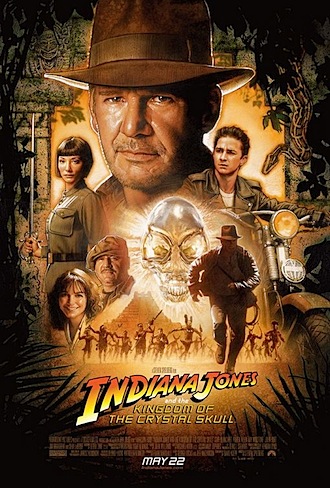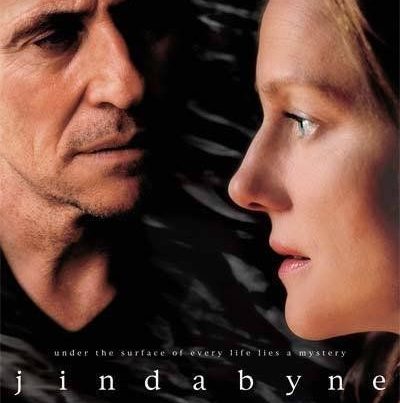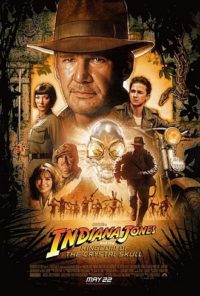 The two universes of Steven Spielberg’s biggest films of the 70’s and 80’s collide in Indiana Jones & The Kingdom of the Crystal Skull as Harrison Ford’s ageing Indie and young pretender Shia LaBoeuf race Soviet ice Queen Cate Blanchett to the secret resting place of lost extra terrestrials in the heart of the Amazon. There’s even a subtle “ET Phone Home” reference which I found kind of cute. Entertaining and a little sloppy (in a good way), Indy has a middle-aged pace about it, a noticeable change from the current trend towards frenetic, percussive, music video action, allowing plenty of time to develop inventive ways to get Harrison Ford into, and out of, trouble. I wasn’t too upset with LaBoeuf (he certainly isn’t JarJar Binks bad) but you can see he has a way to go before he can muster the sort of effortless charisma his elders offer.
The two universes of Steven Spielberg’s biggest films of the 70’s and 80’s collide in Indiana Jones & The Kingdom of the Crystal Skull as Harrison Ford’s ageing Indie and young pretender Shia LaBoeuf race Soviet ice Queen Cate Blanchett to the secret resting place of lost extra terrestrials in the heart of the Amazon. There’s even a subtle “ET Phone Home” reference which I found kind of cute. Entertaining and a little sloppy (in a good way), Indy has a middle-aged pace about it, a noticeable change from the current trend towards frenetic, percussive, music video action, allowing plenty of time to develop inventive ways to get Harrison Ford into, and out of, trouble. I wasn’t too upset with LaBoeuf (he certainly isn’t JarJar Binks bad) but you can see he has a way to go before he can muster the sort of effortless charisma his elders offer.
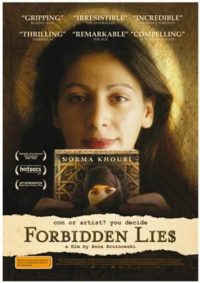 Following the murder of her best friend by her own family in an “honour killing” in Jordan, Norma Khouri escapes to Greece and hastily begins writing a passionate book exposing the practice. The book, Forbidden Love, is published in late 2001 to great acclaim and soon achieves best-seller status but some in Jordan (and in Australia where Norma settles) have questions about the book. Further investigation reveals that nothing in the first 32 words of this paragraph is true and that Norma herself has a more interesting past than she is prepared to own up to. As Norma’s story unravels and the investigation follows her from Bridie Island in Queensland to Chicago and ultimately to Amman in Jordan, you find yourself on a very strange road indeed.
Following the murder of her best friend by her own family in an “honour killing” in Jordan, Norma Khouri escapes to Greece and hastily begins writing a passionate book exposing the practice. The book, Forbidden Love, is published in late 2001 to great acclaim and soon achieves best-seller status but some in Jordan (and in Australia where Norma settles) have questions about the book. Further investigation reveals that nothing in the first 32 words of this paragraph is true and that Norma herself has a more interesting past than she is prepared to own up to. As Norma’s story unravels and the investigation follows her from Bridie Island in Queensland to Chicago and ultimately to Amman in Jordan, you find yourself on a very strange road indeed.
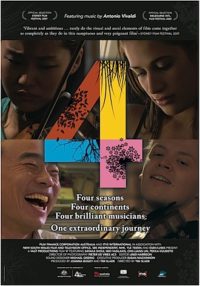 Another non-fiction film, of a completely different order, is the classical music documentary 4. Attempting to rescue Vivaldi’s Four Seasons from TVC cliché, director Tim Slade uses the four movements as a structure to build a portrait of four players, four places and the four seasons themselves. At least that’s what I think the idea is. The problem with the film is that there’s not enough music for it to be a great music movie, there’s not enough insight into the players for the portrait part to work and, while the visuals are often quite beautiful, the film seems to miss the point that four seasons are influential on the human psyche because we see those seasons change from our own perspective and location. Still, 4 is a pleasant enough hour and a half.
Another non-fiction film, of a completely different order, is the classical music documentary 4. Attempting to rescue Vivaldi’s Four Seasons from TVC cliché, director Tim Slade uses the four movements as a structure to build a portrait of four players, four places and the four seasons themselves. At least that’s what I think the idea is. The problem with the film is that there’s not enough music for it to be a great music movie, there’s not enough insight into the players for the portrait part to work and, while the visuals are often quite beautiful, the film seems to miss the point that four seasons are influential on the human psyche because we see those seasons change from our own perspective and location. Still, 4 is a pleasant enough hour and a half.
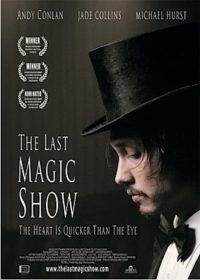 A new entry in the digi-indie-home-made kiwi battler category (previous entries include Wairarapa’s When Night Falls last year) is Andy Conlan’s The Last Magic Show. Conlan himself (who also wrote the script) plays Ronnie Roman, an delusional illusionist who may or may not have real mystical powers. His agent, scenery-chewing Michael Hurst, has set him up for a big come-back show but in the interim he is reduced to volunteering at the local hospice and, possibly, falling in love with Nurse March (Georgie Hill). Conlan has a bit of the young Johnny Depp about him in the looks department but, ultimately, his blank performance creates frustration rather than mystery. Good-looking, odd, strangely paced, The Last Magic Show is an intriguing art movie. Perhaps next time, Conlan shouldn’t try and do all the big creative jobs himself – a better director might have challenged him to come up with a few more layers.
A new entry in the digi-indie-home-made kiwi battler category (previous entries include Wairarapa’s When Night Falls last year) is Andy Conlan’s The Last Magic Show. Conlan himself (who also wrote the script) plays Ronnie Roman, an delusional illusionist who may or may not have real mystical powers. His agent, scenery-chewing Michael Hurst, has set him up for a big come-back show but in the interim he is reduced to volunteering at the local hospice and, possibly, falling in love with Nurse March (Georgie Hill). Conlan has a bit of the young Johnny Depp about him in the looks department but, ultimately, his blank performance creates frustration rather than mystery. Good-looking, odd, strangely paced, The Last Magic Show is an intriguing art movie. Perhaps next time, Conlan shouldn’t try and do all the big creative jobs himself – a better director might have challenged him to come up with a few more layers.
Printed in Wellington’s Capital Times on Wednesday 28 May, 2008.
I hereby apologise to regular readers for the paucity of updates but a fierce combination of the flu and managing this year’s 48 Hours Furious Filmmaking competition have wiped me out and I’m only just coming up for air. And, I’m well behind on my feature-watching: Mama’s Boy has already been and gone from local screens.
Nature of conflict: Forbidden Lie$ is distributed in New Zealand by Richard Dalton at Palace Films who is a mate and The Last Magic Show and 4 are distributed by Arkles Entertainment who are mates and who I do occasional work for.

